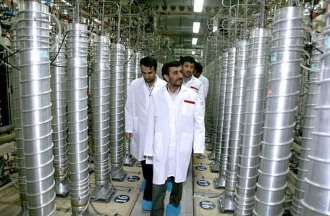With tensions between Iran and the P5+1 growing and the third party enrichment talks at a standstill, Iran appears to be moving on. According to President Mahmoud Ahmadinejad, the nation will next month make an announcement regarding the advancement of its enrichment program.
 So far Iran has only been producing low-enriched uranium at 3.5 percent, usable in its soon to be completed Bushehr power plant. The third part enrichment deal was meant to exchange a portion of the 3.5 percent enriched uranium for 20 percent enriched uranium, usable in an aging US-built reactor in Tehran to produce badly needed medical isotopes.
So far Iran has only been producing low-enriched uranium at 3.5 percent, usable in its soon to be completed Bushehr power plant. The third part enrichment deal was meant to exchange a portion of the 3.5 percent enriched uranium for 20 percent enriched uranium, usable in an aging US-built reactor in Tehran to produce badly needed medical isotopes.
Though Ahmadinejad did not give any specifics, he said the announcement would be “good news” regarding the nation’s need for 20 percent enriched uranium, suggesting that Iran may finally be confident in its ability to produce its own.
Iran originally proposed the third party enrichment scheme to answer Western concerns about the nation’s growing enrichment capabilities. This led to a brief conference which led to a “draft” deal which the P5+1 and IAEA have endorsed, but which Iran says requires more discussion to be finalized. Western nations have angrily rejected the idea of more talks and demand Iran accept the deal as-is.
Though Iran insists its enrichment program is purely civilian in nature, and the IAEA has repeatedly certified that none of the uranium is being diverted to any military purpose, Western nations insist that it is proof of Iran attempting to obtain “breakout capability” to produce a nuclear weapon.


